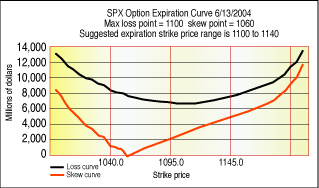Skewed Statistics
Setting Strike Price Probability At Expiration
by David White
Here's one way you can increase your odds for a short-term play.
Nassim Taleb's exceptional book, Fooled By Randomness, helped me finally gain the proper understanding of the probability of hitting a strike price at expiration: "The statistic that 90% of all option positions lost money is meaningless (i.e., the frequency) if we do not take into account how much money is made on average during the remaining 10%."
Let's take a look at what this means.
PRICE AT EXPIRATION
Setting a real-odds number is impossible, as Taleb comments, but there is real information in the bets that people make in the market. For example, I found a website (www.iqauto.com -- click on "maximum pain opts") that gives a strike number where the stock price is most likely to be at expiration. This number is based on finding the centerpoint where the most money would be lost at expiration.
This theory is based on pretty solid ground if you look at other areas of life, such as horse racing. At a pari-mutuel horse track, the odds that are the basis of the payout are calculated by the wagers placed. Just as in the options market, 90% of the time the odds are correct. The tracks pay out 80% of the money, so the only thing they care about is how much the bettors put down, not the way they pick their bets. Nine times out of 10, they skim the 10% difference as profit.
Determining probability by wager has also been used for more surprising purposes, such as finding a submarine lost at sea -- within 1,000 yards (see The Silent War by John Piña Craven). Given a decent sample size, accurate odds can be made on just about anything with this method: Just get enough people together and then bet on it.
Unfortunately, with the financial markets, it's not so simple. In practice, the indexes sometimes expire significantly away from the indicated strike price. Stocks are hit-and-miss, with no apparent reasoning to guide their movements. This suggests that while there is something to the theory of probability by wager, it is not useful in the markets yet.

FIGURE 1: SPX OPTION EXPIRATION CURVE (6/13/04). Here, the maximum loss point is 1100 and the skew point is 1060. This means that the suggested expiration strike price range is from 1100 to 1140. The option settled at 1129.60 and closed at 1135.02.
Excerpted from an article originally published in the December 2004 issue of Technical Analysis of STOCKS & COMMODITIES magazine. All rights reserved. © Copyright 2004, Technical Analysis, Inc.
Return to December 2004 Contents